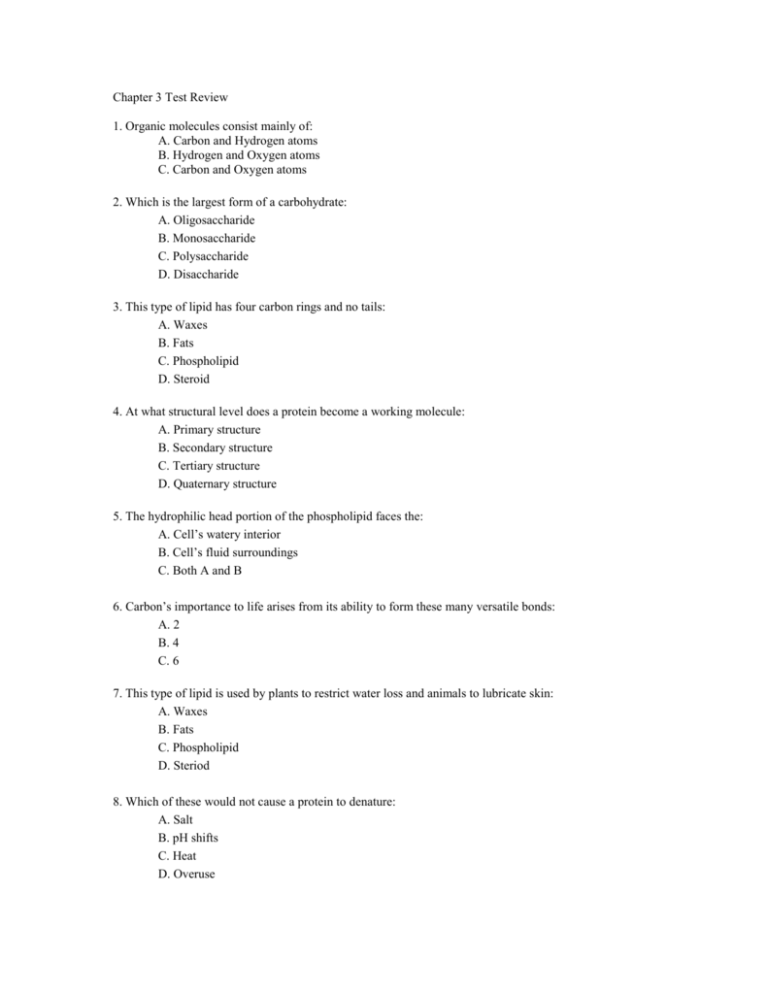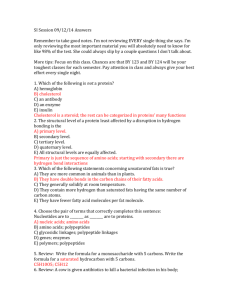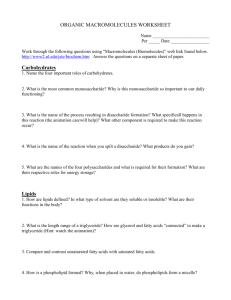File - Principles of Biology 103
advertisement

Chapter 3 Test Review 1. Organic molecules consist mainly of: A. Carbon and Hydrogen atoms B. Hydrogen and Oxygen atoms C. Carbon and Oxygen atoms 2. Which is the largest form of a carbohydrate: A. Oligosaccharide B. Monosaccharide C. Polysaccharide D. Disaccharide 3. This type of lipid has four carbon rings and no tails: A. Waxes B. Fats C. Phospholipid D. Steroid 4. At what structural level does a protein become a working molecule: A. Primary structure B. Secondary structure C. Tertiary structure D. Quaternary structure 5. The hydrophilic head portion of the phospholipid faces the: A. Cell’s watery interior B. Cell’s fluid surroundings C. Both A and B 6. Carbon’s importance to life arises from its ability to form these many versatile bonds: A. 2 B. 4 C. 6 7. This type of lipid is used by plants to restrict water loss and animals to lubricate skin: A. Waxes B. Fats C. Phospholipid D. Steriod 8. Which of these would not cause a protein to denature: A. Salt B. pH shifts C. Heat D. Overuse 9. What is an example of saturated fat: A. Soybean oil B. Canola oil C. Butter D. Corn oil 10. What is the building block of carbohydrates? A. Monosaccharides B. Amino acids C. Fatty acids D. Nucleotides 11. The nonadjacent regions that form to create specific domains is termed: A. Primary structure B. Secondary structure C. Tertiary structure D. Quaternary structure 12. A nucleotide contains: A. A five carbon ring bonded to a nitrogen base and a phosphate group(s) B. A five carbon ring bonded to a phosphate base and a nitrogen group(s) C. A five phosphate ring bonded to a carbon base and a phosphate group(s) 13. The breakdown of large molecules by the enzymatic addition of water is an example of what kind of reaction: A. Hydrolysis B. Oxidation C. Condensation D. Reduction 14. A saturated fat has: A. No double bonds in its tail region B. Double bonds in its tail region 15. Amino acids are small organic compounds that are the basic subunits of: A. Carbohydrates B. Lipids C. Proteins D. Nucleic Acids 16. Metabolism refers to the enzyme-mediated chemical reactions by which cells: A. Acquire and use energy as they build and break down organic molecules B. Maintain constant body temperature C. Have the ability to build monomers from polymers 17. What is the main structural component of plants: A. Starch B. Glycogen C. Cellulose 18. What is the basic structure of a fatty acid: A. A hydrophobic hydrocarbon tail with a hydrophilic carboxyl head B. A hydrophilic hydrocarbon tail with a hydrophobic carboxyl head C. A hydrophobic carboxyl tail with a hydrophilic hydrocarbon head D. A hydrophilic carboxyl tail with a hydrophobic hydrocarbon head 19. The linear series of amino acids linked together in a polypeptide chain is termed: A. Primary structure B. Secondary structure C. Tertiary structure D. Quaternary structure 20. A small molecular group bonded to a carbon of an organic compound that imparts a specific chemical property is this type of group: A. Functional B. Variable C. Organic 21. Carbohydrates have a consistent carbon to hydrogen to oxygen ration of: A. 1:2:2 B. 2:1:2 C. 1:2:1 22. In a cell membrane, phospholipids are arranged in a: A. Monolayer B. Bilayer C. Trilayer 23. Peptide bonds link: A. Monosaccharides B. Fatty Acids C. Amino Acids D. Nucleotides 24. When a protein denatures these bonds are broken: A. Peptide B. Covalent C. Hydrogen 25. The building blocks of nucleic acids are: A. Monosaccharides B. Amino acids C. Fatty acids D. Nucleotides 26. How do cells use monosaccharides: A. As a building block for DNA B. To catalyze metabolic reactions C. For cellular fuel 27. Fatty, oily, or waxy compounds are: A. Carbohydrates B. Lipids C. Proteins D. Nucleic Acids 28. Sucrose is composed of: A. Fructose and Galactose B. Glucose and Galactose C. Fructose and Glucose 29. Which lipid forms cell membranes: A. Saturated fats B. Phospholipids C. Unsaturated fats D. Steriod 30. Which shows growth of a protein: A. amino acid – polypeptide – peptide - protein B. amino acid – peptide – polypeptide - protein C. peptide – amino acid – polypeptide - protein D. polypeptide – amino acid – peptide - protein 31. The bonding of glucose to galactose forms: A. Lactose B. Sucrose C. Maltose 32. Triglycerides contain: A. Glycerol and fatty acids B. Phosphate and fatty acids C. Protein and fatty acids 33. Plants store their monosaccharides in this form: A. Starch B. Glycogen C. Cellulose 34. Which is not a function of a protein: A. Defense B. Enzyme C. Movement D. Transport 35. Which is not a six carbon monosaccharide: A. Glucose B. Sucrose C. Galactose D. Fructose 36. Which amino acid structure defines it and makes it unique: A. Amine group B. Carboxyl group C. R group 37. The formation of large molecules from small subunits is know as what kind of reaction: A. Hydrolysis B. Oxidation C. Condensation D. Reduction 38. Animals store their monosaccharides in this form: A. Starch B. Glycogen C. Cellulose 39. The polypeptide chain that twists and turns is termed: A. Primary structure B. Secondary structure C. Tertiary structure D. Quaternary structure 40. In a chain of nucleotides the sugar of one nucleotide is bonded to the ______________ of the next nucleotide: A. Sugar B. Amine C. Phosphate Name: ___________________ Chapter 3 Test Review 1. ________ 21. _______ 2. ________ 22. _______ 3. ________ 23. _______ 4. ________ 24. _______ 5. ________ 25. _______ 6. ________ 26. _______ 7. ________ 27. _______ 8. ________ 28. _______ 9. ________ 29. _______ 10. _______ 30. _______ 11. _______ 31. _______ 12. _______ 32. ________ 13. _______ 33. ________ 14. _______ 34. ________ 15. _______ 35. ________ 16. _______ 36. ________ 17. _______ 37. ________ 18. _______ 38. ________ 19. _______ 39. ________ 20. _______ 40. ________ Section: ______________







